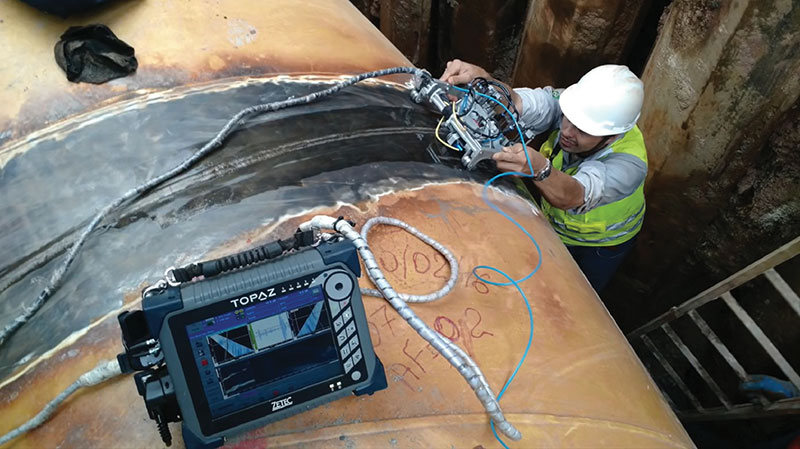Protect Your Investment: Thorough Pipeline Welding Inspection for Satisfaction
Protect Your Investment: Thorough Pipeline Welding Inspection for Satisfaction
Blog Article
Comprehensive Overview of Pipe Welding Examination Procedures
In the realm of pipe building and construction, making sure the honesty and safety and security of welded joints is critical. Pipeline welding assessment treatments play a critical duty in assuring that bonded connections satisfy strict industry standards and specifications. From precise pre-welding assessments to thorough post-weld assessments, a well-defined examination process is crucial for preserving the structural stability of pipes. Comprehending the complexities of welding inspection treatments is not just a regulative demand however likewise a fundamental element of promoting the reliability of these critical infrastructures.
Pre-welding Inspection Preparations
Before commencing the welding process, detailed pre-welding examination prep work are necessary to make sure the stability and quality of the weld joint. These prep work include a careful evaluation of the materials to be bonded, the welding tools, and the job environment. By carrying out complete pre-welding examination prep work, prospective problems can be determined and settled early on, leading to trusted and premium weld joints.
Welding Treatment Credentials
Complete pre-welding assessment prep work lay the foundation for the important process of Welding Treatment Credentials, making sure the integrity and quality of the weld joint. Welding Procedure Credentials (WPQ) is an essential step in the welding process that includes screening and licensing welding treatments to guarantee they meet details requirements and requirements. The WPQ process typically includes welding procedure specification development, welding treatment certification testing, and paperwork of the outcomes.
During welding procedure spec growth, important information such as the welding procedure, welding materials, joint style, and welding criteria are defined to produce a comprehensive procedure. Consequently, welding treatment credentials testing is carried out to verify the recommended treatment's integrity. This testing usually involves welding test vouchers that undergo various mechanical and non-destructive tests to analyze the weld's quality and adherence to the defined criteria.
In-process Weld Inspection
Throughout the welding procedure, in-process weld assessment plays a crucial role in making sure the top quality and honesty of the weld joint - Pipeline Welding Inspection. This type of evaluation entails monitoring the welding specifications, analyzing the weld bead formation, and spotting any type of possible defects or discontinuities as they take place. By performing in-process weld examinations, welding drivers can without delay attend to any kind of concerns that may occur, therefore protecting against further issues and guaranteeing that the last weld satisfies the required specifications
Common methods made use of for in-process weld assessment consist of visual examination, liquid penetrant screening, magnetic particle screening, ultrasonic testing, and radiographic screening. On the whole, in-process weld evaluation is crucial for maintaining the high quality and dependability of welded pipelines.
Non-destructive Screening (NDT)
Non-destructive Screening (NDT) is an important approach utilized look at here now in pipe welding inspection to evaluate the honesty of weld joints without causing damages to the welded structure. By making use of various NDT strategies, inspectors can examine the top quality of welds and identify any kind of issues or interruptions that may endanger the architectural soundness of the pipe. Typical NDT methods made use of in pipe welding examination consist of Radiographic Testing (RT), Ultrasonic Testing (UT), Magnetic Fragment Checking (MPT), Liquid Penetrant Testing (LPT), and Visual Testing (VT)
RT entails using X-rays or gamma rays to produce photos of the internal structure of the weld, permitting assessors to spot issues such as porosity, splits, or insufficient blend. UT makes use of high-frequency sound waves to find imperfections underneath the surface area of the weld, offering comprehensive info concerning the size and area of flaws. MPT and LPT are utilized to identify surface-breaking issues by applying magnetic fragments or penetrant liquids to the weld area. Furthermore, VT includes aesthetic examination of welds to determine any noticeable imperfections.
Post-weld Inspection and Paperwork


Documentation of post-weld assessment findings is crucial for preserving quality control documents and ensuring conformity with industry criteria and policies. Detailed records need to include information concerning the assessment techniques made use of, the place and nature of any kind of flaws found, and any type of rehabilitative actions taken - Pipeline Welding Inspection. Appropriate documents not only functions as a document of the weld's quality yet also aids in future upkeep and examination procedures
Final Thought

To conclude, pipe welding examination treatments play an important function in ensuring the high quality and honesty of welds. From pre-welding evaluations to post-weld documents, each action is vital in keeping the safety and effectiveness of pipes. By adhering to recognized treatments and performing thorough evaluations, possible issues can be identified and dealt with prior to they bring about costly repair work or failures. Generally, adherence to correct inspection protocols is essential to the success of pipeline welding jobs.
From precise pre-welding evaluations to extensive post-weld evaluations, a well-defined content evaluation process is vital for preserving the structural stability of pipelines. By conducting in-process weld inspections, welding drivers can without delay resolve any kind of concerns that might arise, thereby stopping additional flaws and making certain that the final weld fulfills the needed requirements.
Common methods used for in-process weld examination include aesthetic assessment, fluid penetrant testing, magnetic bit testing, ultrasonic screening, and radiographic testing.Non-destructive Screening (NDT) is a vital technique utilized in pipe welding assessment to analyze the honesty of weld joints without creating damages to the bonded framework. Post-weld evaluation entails different methods to examine the welds for problems, consisting of visual inspection, color penetrant testing, magnetic fragment testing, ultrasonic screening, and radiographic screening.
Report this page